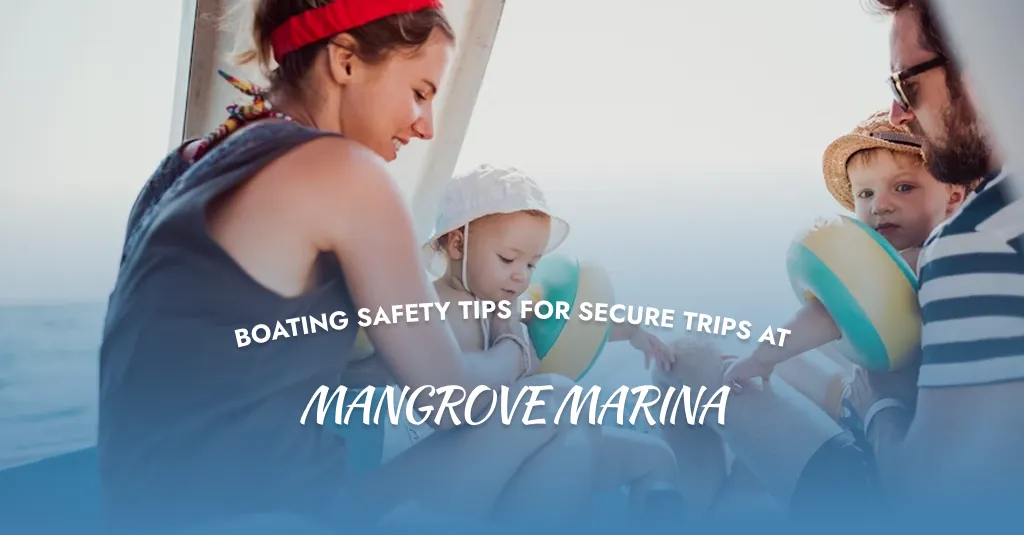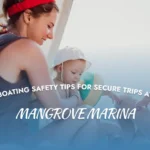
Boating Safety Tips for Secure Trips at Mangrove Marina
Make one plan for boating through the Florida Keys and make it the best experience from the comforts of Mangrove Marina. Whether you are a weekend voyager, a renter, or even a liveaboard, knowing and practicing these boating safety Tips will make it possible for your safety and turn this experience into a much more enjoyable water activity. The waters of the Keys are gorgeous but unpredictable, so it pays to prepare and learn-the skills and knowledge are the best tools.
In this blog, we’ll cover the most important safety practices, including storm readiness, navigation awareness, anchoring rules, and emergency preparedness, so you can enjoy the ocean while staying safe and confident.
What safety practices should boaters, renters, and liveaboards follow when using Mangrove Marina and the Florida Keys waters?
A little understanding and due protection would be required for a person sailing in the waters of the Florida Keys. The marina is a good starting point, but once you leave the dock, it is up to you to put some habits into practice for your safety. All the good boating safety tips for Hawaii would have to address such matters as changes in weather conditions, shallow reefs, and the much-increased waterway traffic.
Building habits for safety and comfort
Renters need to know what the boat does before getting underway. Liveaboards should always keep the boat stocked, inclusive of an emergency kit, while boaters getting on regularly should check their gear and check for updates in local navigation daily. The local rules are important to go over; these rules usually pay attention to speed zones, wake zones, and restrictions on anchoring.
What are common threats (storms, strong currents, shallow reefs)?
The Florida Keys are stunning, but the waters hold natural challenges every boater must anticipate. Sudden storms, shifting currents, and hidden reefs can turn a pleasant outing into a serious hazard.
Preparing for Florida’s changing weather
Storms in this region can arrive quickly. Practicing storm preparation means checking forecasts before departure, carrying waterproof radios, and knowing safe harbors to retreat to if conditions worsen. Ignoring warning signs can place your boat and passengers at risk.
Respecting currents and reefs
Currents in channels often intensify, especially with shifting tides, so slow and steady navigation is crucial. Shallow reefs, although beautiful, can damage hulls and injure marine ecosystems if struck. Keeping charts updated and using GPS enhances navigation safety in these waters.
What safety gear is essential?
No boating trip is complete without the right equipment. Safety gear ensures you can respond to unexpected issues quickly and effectively.
Essentials every boat should carry
It is not negotiable to wear life jackets. Peace of mind is offered by an emergency kit that is well-stocked with radios, flashlights, flares, and first aid supplies. For longer journeys or living on board, fire extinguishers and operational bilge pumps are equally crucial. In an emergency, having dependable communication tools keeps you in touch.
Comfort and compliance gear
Together, these things reduce, or at least diminish, risk and worry when you are out on the water. Having food, fresh water, and sun protection enhances the experience, and having your insurance, licenses, and registration documents helps you meet the local rules.
How to plan for emergencies?
Even experienced boaters face unpredictable moments, making emergency planning critical. Having a structured approach minimizes panic and maximizes survival chances.
Crafting a response mindset
Before departing, consider basic operational scenarios such as engine failure, grounding, or medical emergencies. Practice the plan with passengers so they know their responsibilities. It is only important to have stocked the emergency kit, but, at least as important, is knowing how the items are used.
Staying calm and connected
Communicating is everything in an emergency. Make sure VHF radios work, and cell phones are charged. Getting the Coast Guard or a nearby boat on the phone quickly made a big difference. Next to these steps, have a clear head. Those two areas will help take care of challenges with courage.
What local navigation/tide info is crucial?
The Florida Keys are shaped by tides and intricate waterways, and understanding these conditions is key to safe passage.
Why do tides matter around the Keys?
Tides influence not only depth but also current strength. Entering or leaving Mangrove Marina during strong tidal flow requires extra caution to avoid collisions or grounding. Charts and local tide apps make planning smoother.
Following navigation markers
Navigation markers guide boats safely through channels and around reefs. Ignoring them risks damage to your vessel and harm to protected habitats. Staying updated on navigation safety guidelines ensures smoother journeys.
What are the rules for anchoring near mangroves or reefs?
Anchoring responsibly protects both boaters and the fragile marine ecosystem. Understanding and following anchoring rules preserves the Keys for future generations.
Choosing safe anchoring spots
Boaters should avoid dropping anchors directly onto coral reefs, as this damages both reefs and anchors. Instead, locate sandy bottoms away from sensitive habitats. Practicing safe anchoring also means ensuring lines are secure and the anchor holds in changing currents.
Respecting protected areas
Anchoring near mangroves is restricted in certain zones to protect ecosystems. Review local rules before dropping anchor, and use mooring buoys whenever available. This practice combines environmental responsibility with boating safety.
Conclusion
Be Safe While Traveling the Florida Keys! Get familiar with the basic rules of boating safety, be ready in case any storm threatens, know and follow the water’s laws, and always have a plan for staying safe. If you watch out, you can keep yourself and the Keys in good condition. And if you rent, live aboard, or just boat frequently, all the better.
Ready to set sail with confidence? Visit Mangrove Marina and apply these safety practices to make every trip both secure and unforgettable.
FAQs
Before renting a boat in the Florida Keys, do I require any special training?
Yes, renters should receive a safety briefing and basic navigation instructions so they can understand local boating safety tips.
How can collisions in crowded channels be prevented?
To maintain navigation safety, abide by posted markers, stay to the right, and slow down when other boats are close by.
Is there somewhere I can anchor near Mangrove Marina?
No, you must follow local laws and avoid areas with protected reefs and mangroves. To anchor safely, look for mooring fields that have been designated.
Why should you absolutely have an emergency kit when the travel is not long?
An emergency kit will always make you ready for any unpredictable weather change, an unexpected engine jam, or even when someone meets a loss.





